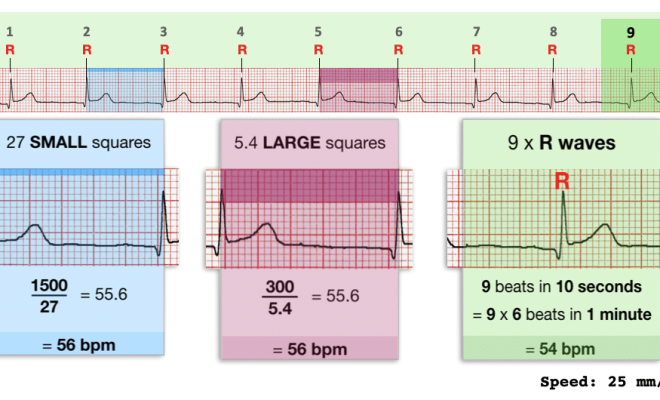How to calculate heart rate from electrocardiogram

Introduction:
An electrocardiogram (ECG or EKG) is a diagnostic tool that measures and records the electrical activity of the heart. It is frequently used in medical practice to identify abnormalities in heart rhythm, assess overall cardiac performance, and detect potential heart problems. One key piece of information derived from an ECG is the heart rate, which reflects how fast the heart is beating. In this article, we will discuss how to calculate heart rate from an electrocardiogram.
Step 1: Understand the basic ECG waveform
An ECG waveform consists of a sequence of repetitive deflections, known as P, Q, R, S, and T waves. The P wave signifies atrial depolarization, while the QRS complex represents ventricular depolarization. The T wave reflects ventricular repolarization.
Step 2: Identify a complete cardiac cycle on the ECG
A complete cardiac cycle on an ECG comprises one P wave followed by a QRS complex and a T wave. To calculate the heart rate, first identify a complete cardiac cycle on the electrocardiogram.
Step 3: Measure the distance between two consecutive R-waves
The distance between two consecutive R waves (R-R interval) indicates the time taken for one complete cardiac cycle. Locate two consecutive R-peaks on the ECG strip and measure the distance between them.
Step 4: Use the “300 Rule” or “1500 Rule” to estimate heart rate
To calculate heart rate from the measured R-R interval, you can use either the “300 Rule” or “1500 Rule.” The choice depends on whether your ECG has large or small boxes.
For large boxes:
1. Count the number of large boxes between two consecutive R-peaks.
2. Divide 300 by this number to estimate the heart rate (in beats per minute).
For small boxes:
1. Count the number of small boxes between two consecutive R-peaks.
2. Divide 1500 by this number to estimate the heart rate (in beats per minute).
For example, if you count four large boxes between two R-peaks, your estimated heart rate would be 300/4 = 75 beats per minute.
Step 5: Confirm the accuracy of your calculation
Always assess the regularity of the rhythm before finalizing your calculation. If the rhythm is irregular or you’re unsure about your estimation, consider calculating the heart rate over several cardiac cycles and averaging the results.
Conclusion:
Calculating heart rate from an electrocardiogram can be a simple yet effective way to gain insight into an individual’s cardiac performance. By identifying a complete cardiac cycle, measuring the distance between consecutive R-waves, and applying either the “300 Rule” or “1500 Rule,” you can estimate a person’s heart rate. With practice, this skill can become a valuable tool in cardiac assessment and monitoring.






